An Analytical Algorithm for Extracting Model Parameters in a Lumped-Parameter Equivalent Circuit of Solar Cells
Abstract
:1. Introduction
2. Algorithm of Extracting Model Parameters in the Single-Diode Lumped-Parameter Equivalent Circuit
3. Verification and Discussion
4. Conclusions
Author Contributions
Funding
Institutional Review Board Statement
Informed Consent Statement
Data Availability Statement
Acknowledgments
Conflicts of Interest
References
- Wang, Y.B.; Liu, X.; Zhou, Z.M.; Ru, P.B.; Chen, H.; Yang, X.D.; Han, L.Y. Reliable measurement of perovskite solar cells. Adv. Mater. 2019, 31, 1803231. [Google Scholar] [CrossRef]
- Boutana, N.; Mellit, A.; Haddad, S.; Rabhi, A.; Pavan, A.M. An explicit IV model for photovoltaic module technologies. Energy Convers. Manag. 2017, 138, 400–412. [Google Scholar] [CrossRef]
- Senturk, A.; Eke, R. A new method to simulate photovoltaic performance of crystalline silicon photovoltaic modules based on datasheet values. Renew. Energy 2016, 103, 58–69. [Google Scholar] [CrossRef]
- Fallahazad, P.; Naderi, N.; Eshraghi, M.J. Improved photovoltaic performance of graphene-based solar cells on textured silicon substrate. J. Alloys Compd. 2020, 834, 155123. [Google Scholar] [CrossRef]
- Batzelis, I.E. Simple PV performance equations theoretically well founded on the single-diode model. IEEE J. Photovolt. 2017, 7, 1400–1409. [Google Scholar] [CrossRef]
- Brano, V.L.; Orioli, A.; Ciulla, G.; Gangi, A.D. An improved five-parameter model for photovoltaic modules. Sol. Energy Mater. Sol. Cells 2010, 94, 1358–1370. [Google Scholar] [CrossRef]
- Phang, J.C.H.; Chan, D.S.H.; Phillips, J.R. Accurate analytical method for the extraction of solar cell model parameters. Electron. Lett. 1984, 20, 406–408. [Google Scholar] [CrossRef]
- Batzelis, E. Non-iterative methods for the extraction of the single-diode model parameters of photovoltaic modules: A review and comparative assessment. Energies 2019, 12, 358. [Google Scholar] [CrossRef] [Green Version]
- Ortiz-Conde, A.; García-Sánchez, F.J.; Muci, J.; Sucre-González, A. A review of diode and solar cell equivalent circuit model lumped parameter extraction procedures. FU Electron. Energetics 2014, 27, 57–102. [Google Scholar] [CrossRef]
- Cubas, J.; Pindado, S.; Victoria, M. On the analytical approach for modeling photovoltaic systems behavior. J. Power Sources 2013, 247, 467–474. [Google Scholar] [CrossRef] [Green Version]
- Khan, F.; Baek, S.; Park, Y.; Kim, J.H. Extraction of diode parameters of silicon solar cells under high illumination conditions. Energy Convers. Manag. 2013, 76, 421–429. [Google Scholar] [CrossRef]
- Yu, F.; Huang, G.; Xu, C. An explicit method to extract fitting parameters in lumped-parameter equivalent circuit model of industrial solar cells. Renew. Energy 2019, 146, 2188–2198. [Google Scholar] [CrossRef]
- Wei, T.; Yu, F.; Huang, G.; Xu, C. A particle-swarm-optimization-based parameter extraction routine for three-diode lumped parameter model of organic solar cells. IEEE Electron. Device Lett. 2019, 40, 1511–1514. [Google Scholar] [CrossRef]
- Toledo, F.J.; Blanes, J.M.; Galiano, V. Two-step linear least-squares method for photovoltaic single-diode model parameters extraction. IEEE Trans. Ind. Electron. 2018, 65, 6301–6308. [Google Scholar] [CrossRef]
- García-Sánchez, F.J.; Ortiz-Conde, A.; Mercato, G.D.; Liou, J.J.; Rechi, L. Eliminating parasitic resistances in parameter extraction of semiconductor device models. In Proceedings of the First International Caracas Conference on Devices, Circuits and Systems, Caracas, Venezuela, 12–14 December 1995; pp. 298–302. [Google Scholar]
- Ortiz-Conde, A.; Sánchez, F.J.G. Extraction of non-ideal junction model parameters from the explicit analytic solutions of its I–V characteristics. Solid State Electron. 2004, 49, 465–472. [Google Scholar] [CrossRef]
- Nacar, M.; Özer, E.; Yılmaz, A.E. A six parameter single diode model for photovoltaic modules. J. Sol. Energy Eng. 2021, 143, 112. [Google Scholar] [CrossRef]
- Sharma, A.; Averbukh, M.; Jately, V.; Azzopardi, B. An effective method for parameter estimation of a solar cell. Electronics 2021, 10, 312. [Google Scholar] [CrossRef]
- Wang, J.; Yang, B.; Li, D.; Zeng, C.; Chen, Y.; Guo, Z. Photovoltaic cell parameter estimation based on improved equilibrium optimizer algorithm. Energy Convers. Manag. 2021, 236, 114051. [Google Scholar] [CrossRef]
- Shongwe, S.; Hanif, M. Comparative analysis of different single-diode PV modeling methods. IEEE J. Photovolt. 2015, 5, 938–946. [Google Scholar] [CrossRef]
- Villalva, M.G.; Gazoli, J.R.; Filho, E.R. Comprehensive approach to modeling and simulation of photovoltaic arrays. IEEE Trans. Power Electron. 2009, 24, 1198–1208. [Google Scholar] [CrossRef]
- Ishaque, K.; Salam, Z.; Taheri, H.; Syafaruddin. Modeling and simulation of photovoltaic (PV) system during partial shading based on a two-diode model. Simul. Model. Pract. Theory 2011, 19, 1613–1626. [Google Scholar] [CrossRef]
- Ma, W.; Zhang, Z.; Ma, M.; Liu, Y.; Pan, G.; Gao, H.; Mao, Y. CuGaS2 quantum dots with controlled surface defects as an hole-transport material for high-efficient and stable perovskite solar cells. Sol Energy 2020, 211, 55–61. [Google Scholar] [CrossRef]
- Shell SM55 Photovoltaic Solar Module. Available online: http://www.aeet-service.com/pdf/shell/Shell-Solar_SM55.pdf (accessed on 17 January 2017).
- Saeed, M.A.; Kim, S.H.; Kim, H.; Liang, J.; Woo, H.Y.; Kim, T.G.; Yan, H.; Shim, J.W. Indoor organic photovoltaics: Optimal cell design principles with synergistic parasitic resistance and optical modulation effect. Adv. Energy Mater. 2021, 11, 27. [Google Scholar] [CrossRef]
- Saeed, M.A.; Kang, H.C.; Yoo, K.; Asiam, F.K.; Lee, J.J.; Shim, J.W. Cosensitization of metal-based dyes for high-performance dye-sensitized photovoltaics under ambient lighting conditions. Dye. Pigment. 2021, 194, 109624. [Google Scholar] [CrossRef]
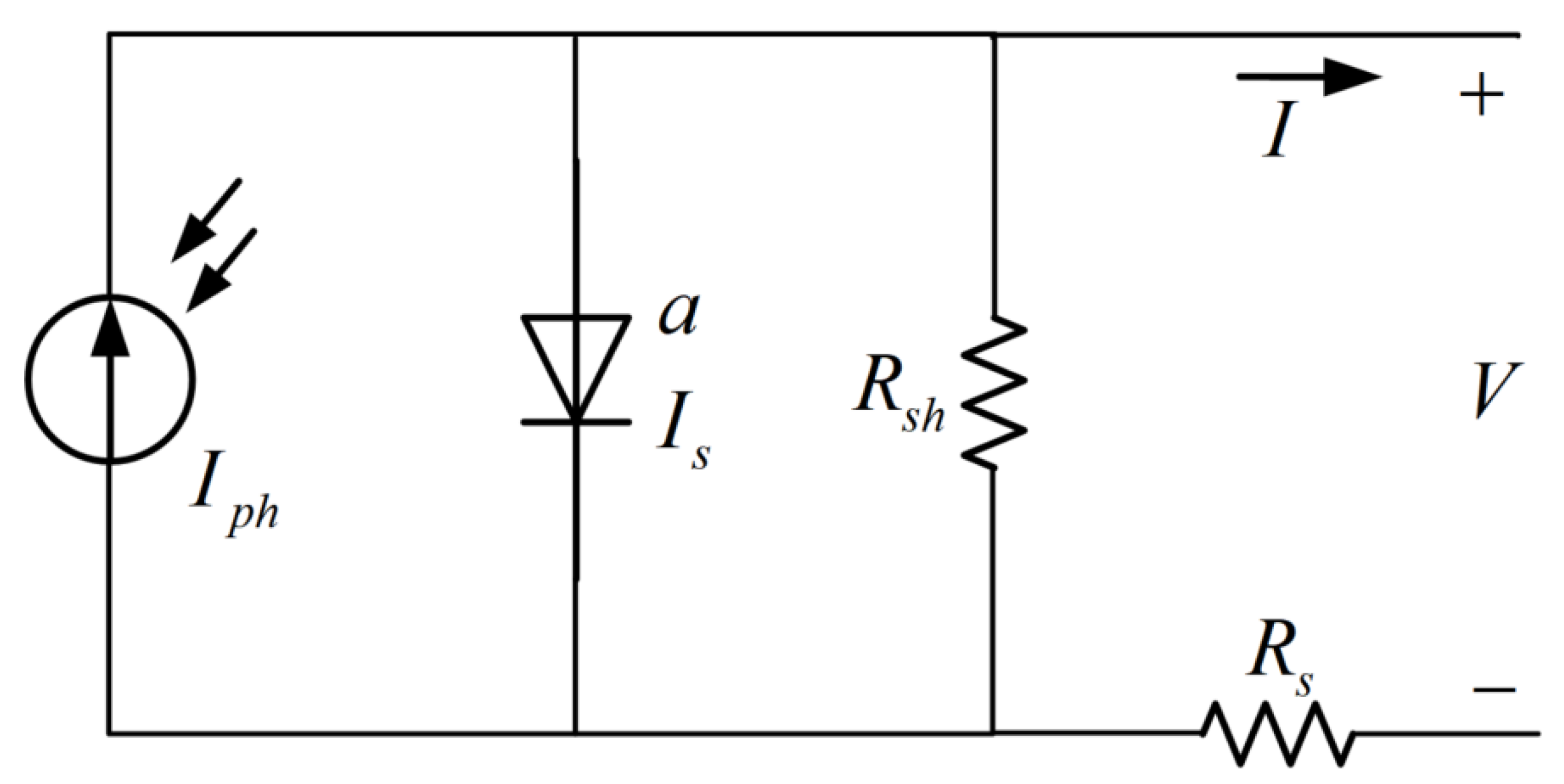



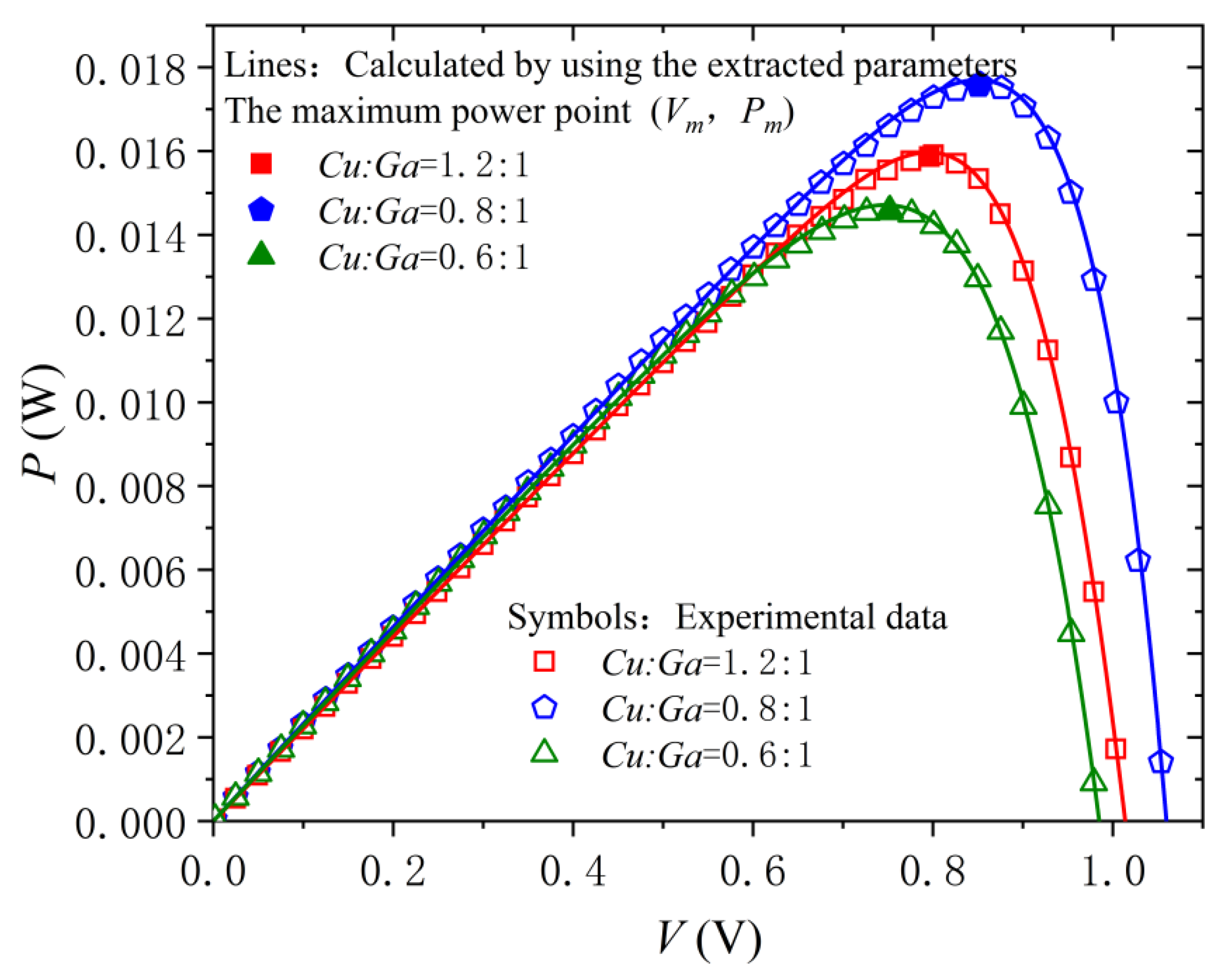

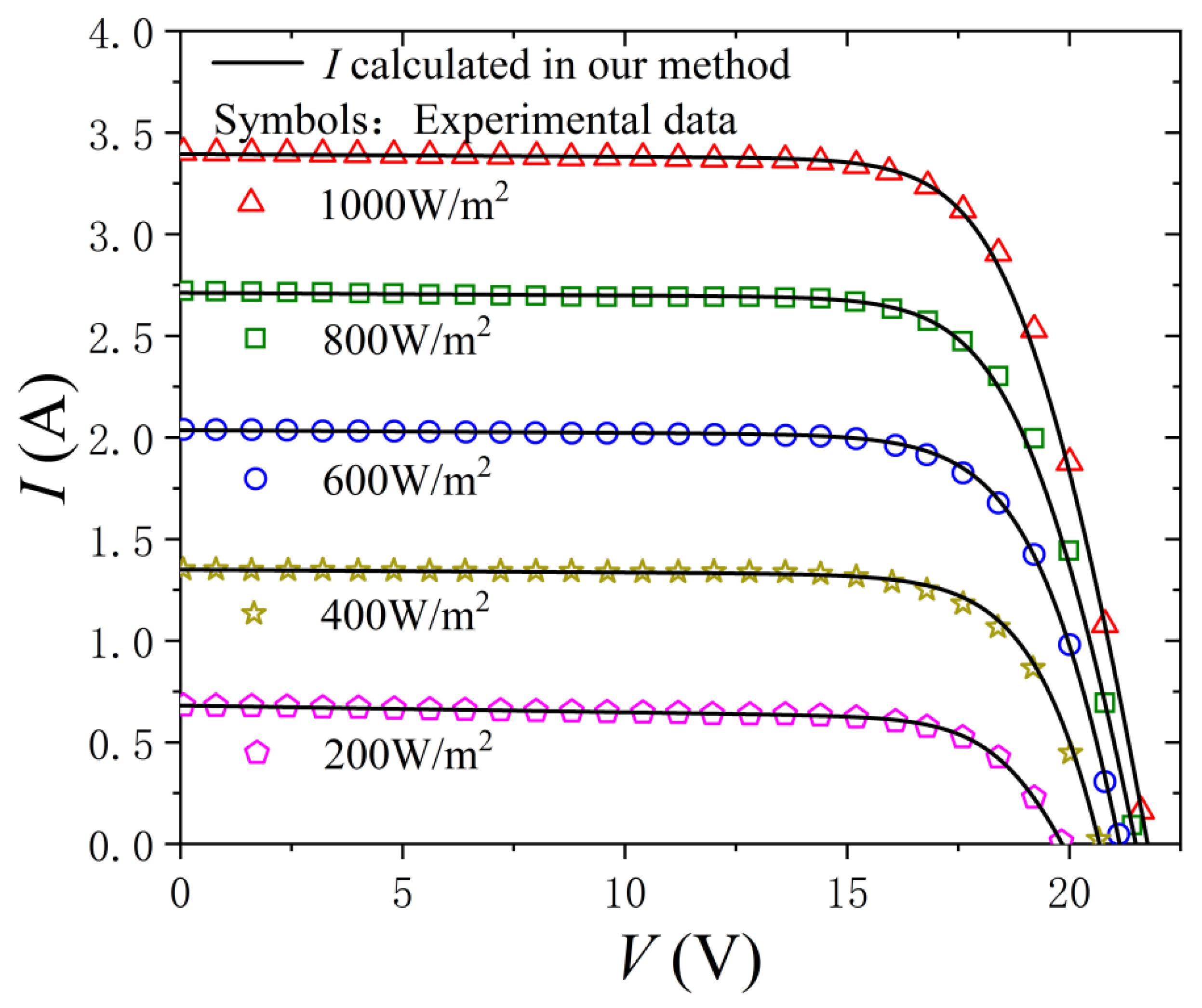



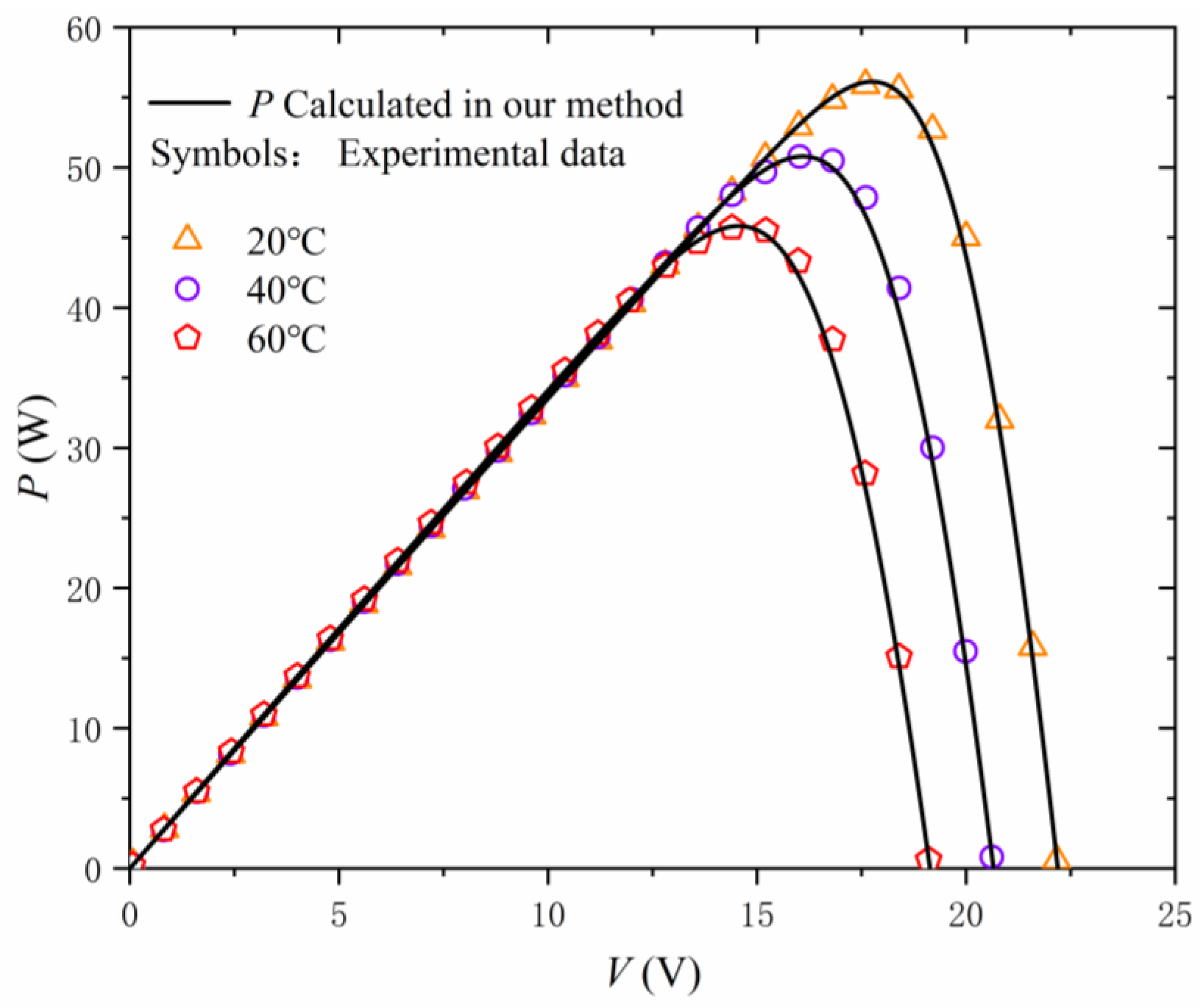
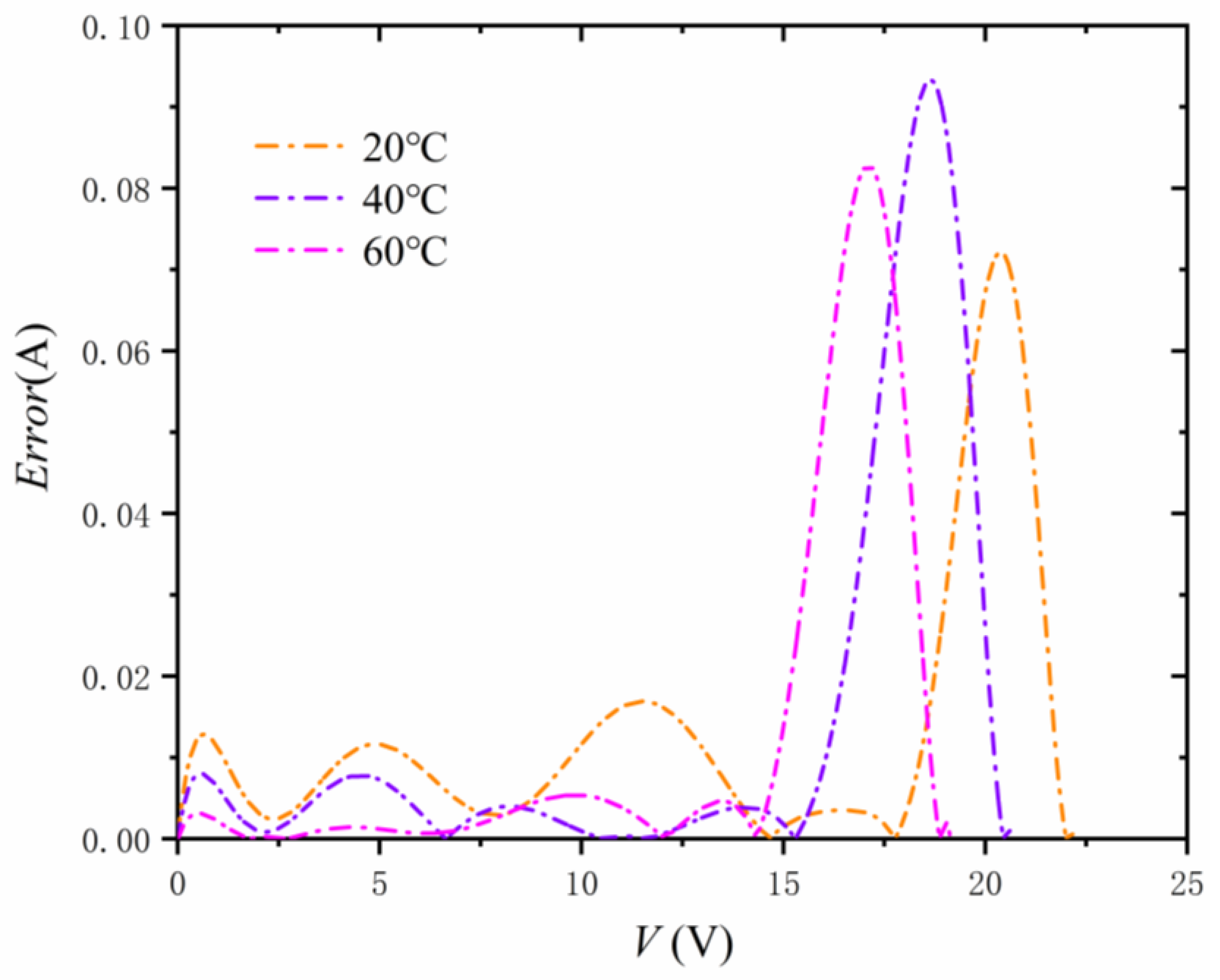
| Symbols | Settled Model Parameters | Extracted Model Parameters |
|---|---|---|
| Iph (A) | 1.670000 | 1.670005 |
| Is (μA) | 1.250000 | 1.245185 |
| a | 0.100854 | 0.100826 |
| Rsh (Ω) | 10.00000 | 9.997104 |
| Rs (Ω) | 0.048000 | 0.048024 |
| Relevant Factors | Settled Model Parameters | Extracted Model Parameters |
|---|---|---|
| Isc (A) | 1.662020 | 1.662019 |
| Voc (V) | 1.413645 | 1.413645 |
| P(W) = Isc × Voc | 2.349507 | 2.349504 |
| Im (A) | 1.423923 | 1.423924 |
| Vm (V) | 1.096422 | 1.096432 |
| Pm(W) = Im × Vm | 1.561220 | 1.561236 |
| FF = Pm/(Voc × Isc) | 66.4489% | 66.4496% |
| Rsc (Ω) | 10.04513 | 10.04234 |
| Roc (Ω) | 0.113551 | 0.113605 |
| Cu:Ga | 1.2:1 | 0.8:1 | 0.6:1 |
|---|---|---|---|
| Iph (A) | 0.0220853 | 0.0233143 | 0.0228886 |
| Is (A) | 4.3673630 × 10−9 | 2.7389066 × 10−8 | 7.2781006 × 10−7 |
| Rs (Ω) | 2.6339570 | 0.8082216 | 1.6242257 |
| Rsh (Ω) | 3352.4723 | 1437.2007 | 1211.0273 |
| a | 0.0657331 | 0.0777924 | 0.0954416 |
| Cu:Ga | 1.2:1 | 0.8:1 | 0.6:1 | |||
|---|---|---|---|---|---|---|
| Parameters | Symbol | Line | Symbol | Line | Symbol | Line |
| Isc (A) | 0.022068 | 0.022068 | 0.023301 | 0.023301 | 0.022856 | 0.022855 |
| Voc (V) | 1.013767 | 1.013767 | 1.059711 | 1.059710 | 0.984946 | 0.984944 |
| P(W) = Isc × Voc | 0.022372 | 0.022372 | 0.024692 | 0.024692 | 0.022512 | 0.022511 |
| Im (A) | 0.019924 | 0.020075 | 0.020654 | 0.020821 | 0.019381 | 0.019694 |
| Vm (V) | 0.796342 | 0.795425 | 0.852356 | 0.849933 | 0.752065 | 0.746969 |
| Rsc (Ω) | 3355.106 | 3354.243 | 1438.009 | 1440.564 | 1012.652 | 1012.078 |
| Roc (Ω) | 5.938071 | 5.913439 | 4.589079 | 4.585644 | 6.271030 | 6.214534 |
| Pm(W) = Im × Vm | 0.015866 | 0.015968 | 0.017604 | 0.017697 | 0.014576 | 0.014711 |
| FF = Pm/(Voc × Isc) | 70.9209% | 71.3756% | 71.2947% | 71.6678% | 64.7478% | 65.3480% |
| Irradiance (W/m2) | 1000 | 800 | 600 | 400 | 200 |
|---|---|---|---|---|---|
| Iph (A) | 3.3962417 | 2.7131558 | 2.0363498 | 1.3493865 | 0.6827725 |
| Is (A) | 7.308938 × 10−10 | 1.403863 × 10−9 | 1.092685 × 10−8 | 8.576250 × 10−9 | 8.328075 × 10−11 |
| Rs (Ω) | 0.5430073 | 0.5676721 | 0.4013254 | 0.3015109 | 1.0673264 |
| Rsh (Ω) | 788.55654 | 776.54018 | 765.691502 | 728.019704 | 300.01679 |
| a | 0.9779623 | 1.0057922 | 1.1105125 | 1.0968676 | 0.8729821 |
| Parameters | 20 °C | 40 °C | 60 °C |
|---|---|---|---|
| Iph (A) | 3.3683097 | 3.4030083 | 3.4286977 |
| Is (A) | 9.2486844 × 10−11 | 5.9109404 × 10−9 | 5.3839465 × 10−8 |
| Rs (Ω) | 0.5621175 | 0.5656343 | 0.5869989 |
| Rsh (Ω) | 732.52200 | 788.74959 | 864.79641 |
| a | 0.9129523 | 1.0244086 | 1.0653797 |
Publisher’s Note: MDPI stays neutral with regard to jurisdictional claims in published maps and institutional affiliations. |
© 2022 by the authors. Licensee MDPI, Basel, Switzerland. This article is an open access article distributed under the terms and conditions of the Creative Commons Attribution (CC BY) license (https://creativecommons.org/licenses/by/4.0/).
Share and Cite
Ma, Y.; Liu, J.; Huang, J.; Deng, W. An Analytical Algorithm for Extracting Model Parameters in a Lumped-Parameter Equivalent Circuit of Solar Cells. Energies 2022, 15, 2221. https://doi.org/10.3390/en15062221
Ma Y, Liu J, Huang J, Deng W. An Analytical Algorithm for Extracting Model Parameters in a Lumped-Parameter Equivalent Circuit of Solar Cells. Energies. 2022; 15(6):2221. https://doi.org/10.3390/en15062221
Chicago/Turabian StyleMa, Yunhan, Jingxian Liu, Junkai Huang, and Wanling Deng. 2022. "An Analytical Algorithm for Extracting Model Parameters in a Lumped-Parameter Equivalent Circuit of Solar Cells" Energies 15, no. 6: 2221. https://doi.org/10.3390/en15062221
APA StyleMa, Y., Liu, J., Huang, J., & Deng, W. (2022). An Analytical Algorithm for Extracting Model Parameters in a Lumped-Parameter Equivalent Circuit of Solar Cells. Energies, 15(6), 2221. https://doi.org/10.3390/en15062221





